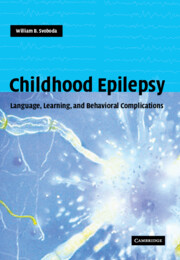Book contents
- Frontmatter
- Contents
- Preface
- Glossary
- 1 Looking ahead
- Part I Speech and language problems
- Part II Learning problems
- Part III Behavior problems
- 27 Mental health needs
- 28 Psychologic development
- 29 Seizure types and modifying factors
- 30 Overview: extrinsic factors
- 31 Behavior problems: general
- 32 Attention deficit disorders
- 33 Anxiety disorders
- 34 Mood disorders
- 35 Disruptive behavior problems
- 36 Psychoses of epilepsy
- 37 Non-epileptic events
- 38 Possible treatment issues
- 39 Helping with psychiatric problems
- 40 Epilog
- Index
- References
38 - Possible treatment issues
from Part III - Behavior problems
Published online by Cambridge University Press: 26 October 2009
- Frontmatter
- Contents
- Preface
- Glossary
- 1 Looking ahead
- Part I Speech and language problems
- Part II Learning problems
- Part III Behavior problems
- 27 Mental health needs
- 28 Psychologic development
- 29 Seizure types and modifying factors
- 30 Overview: extrinsic factors
- 31 Behavior problems: general
- 32 Attention deficit disorders
- 33 Anxiety disorders
- 34 Mood disorders
- 35 Disruptive behavior problems
- 36 Psychoses of epilepsy
- 37 Non-epileptic events
- 38 Possible treatment issues
- 39 Helping with psychiatric problems
- 40 Epilog
- Index
- References
Summary
Any therapy, be it drug, surgery, or other approaches, can produce adverse effects in a minority as well as benefits in a majority of patients. The goal is to choose the right therapy for the individual in terms of benefit and tolerance.
Antiepileptic drugs
Antiepileptic medications can produce side effects alone or in combinations with other drugs. In monotherapy, the side effects of the drugs can be noted (Herranz et al., 1988). Any antiepileptic drug may produce emotional problems, especially in young, elderly, and or brain-damaged patients. Milder forms of the behaviors are transient, fading after two to three weeks. More severe and persistent problems may be accentuations of previous tendencies brought out by the drug or may be a pre-existing problem that is later blamed on the drug. The rates of these effects are highly variable (Weisbrot & Ettinger, 1998).
Problems can range from inattention, hyperactivity, or depression to a major psychotic reaction, seen in 1% of patients. Psychiatric reactions are not simply idiosyncratic but depend on the drug's anticonvulsant strength and the patient's genetic and biological psychiatric predisposition. The principal three types of complications are toxic (3%), metabolic (3%), and allergic (1%) (Schmitz, 1999; Vaintrub, 1998). Brain-damaged and retarded children are more susceptible to the adverse behaviors of antiepileptic drugs (Schain, 1983).
The risks for reactions relate to the severity of the epilepsy, polytherapy, rapid drug titration, high dosage, forced normalization, drug withdrawal, and folate deficiency.
- Type
- Chapter
- Information
- Childhood EpilepsyLanguage, Learning and Behavioural Complications, pp. 590 - 615Publisher: Cambridge University PressPrint publication year: 2004



